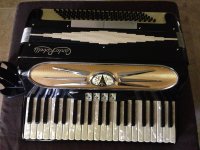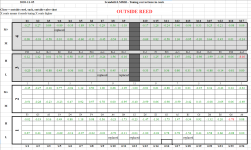Evan
Member
Hey! In my pursuit of a bandoneon, I found a used accordion at an Estate Sale and bought it!
I have several questions that I couldn't find answers to a search of prior threads. If there are threads on any of these topics, please direct me to them. Thank you!
Accordion: Carlo Robelli, 120 button, piano accordion, two reed boxes (per side), push and pull tone the same on both side. "MADE IN ITALY, SER 59334"
Q1: Can anyone direct me to where I might be able to tell the year that this accordion was made? By the look of its carrier case, I'd guess in the 70's. But I'm wondering if there are places where the serial number can be used to learn more about this specific accordion.
Q2: I'd like to replace the back pad / bellow pad. The one that was on there disintegrated. Red sand everywhere... Anyone have favored online retail stores for these types of items? (And are they all the same size for 120's?) I probably will want to buy new shoulder straps too eventually.
Q3: I'd like to get more familiar with the exact chord structure for each of the Bass buttons. Is there a diagram anywhere that labels the buttons, AND provides the musical notes on a treble and bass staff for each button? I can find a button diagram by itself with a Google search. And I understand the basic button arrangement. (3rd, root, M, m, 7th, D). What I am lacking is a staff with the chord notes listed. So I thought a combo diagram plus musical staff would be helpful.
Q4: I think I will want to do some tuning on it myself at some point so...
a) Anyone know of where I can buy an air box for that? Ie. A bellow with air plate on top to put the reed boxes on to test and tune individual reeds. Something like this: Or do people usually just end up having to make those themselves? Any other "out of the accordion" reed testing methods are welcome. So far I've just used my own breath, but that doesn't seem the best.
And.. b) Anyone know how much one can change a reed's pitch by grinding it with a Dremel before the reed is damaged beyond function? I may want to change pitch by several Hertz.
Thanks for any input you can provide! Evan
I have several questions that I couldn't find answers to a search of prior threads. If there are threads on any of these topics, please direct me to them. Thank you!
Accordion: Carlo Robelli, 120 button, piano accordion, two reed boxes (per side), push and pull tone the same on both side. "MADE IN ITALY, SER 59334"
Q1: Can anyone direct me to where I might be able to tell the year that this accordion was made? By the look of its carrier case, I'd guess in the 70's. But I'm wondering if there are places where the serial number can be used to learn more about this specific accordion.
Q2: I'd like to replace the back pad / bellow pad. The one that was on there disintegrated. Red sand everywhere... Anyone have favored online retail stores for these types of items? (And are they all the same size for 120's?) I probably will want to buy new shoulder straps too eventually.
Q3: I'd like to get more familiar with the exact chord structure for each of the Bass buttons. Is there a diagram anywhere that labels the buttons, AND provides the musical notes on a treble and bass staff for each button? I can find a button diagram by itself with a Google search. And I understand the basic button arrangement. (3rd, root, M, m, 7th, D). What I am lacking is a staff with the chord notes listed. So I thought a combo diagram plus musical staff would be helpful.
Q4: I think I will want to do some tuning on it myself at some point so...
a) Anyone know of where I can buy an air box for that? Ie. A bellow with air plate on top to put the reed boxes on to test and tune individual reeds. Something like this: Or do people usually just end up having to make those themselves? Any other "out of the accordion" reed testing methods are welcome. So far I've just used my own breath, but that doesn't seem the best.
And.. b) Anyone know how much one can change a reed's pitch by grinding it with a Dremel before the reed is damaged beyond function? I may want to change pitch by several Hertz.
Thanks for any input you can provide! Evan


